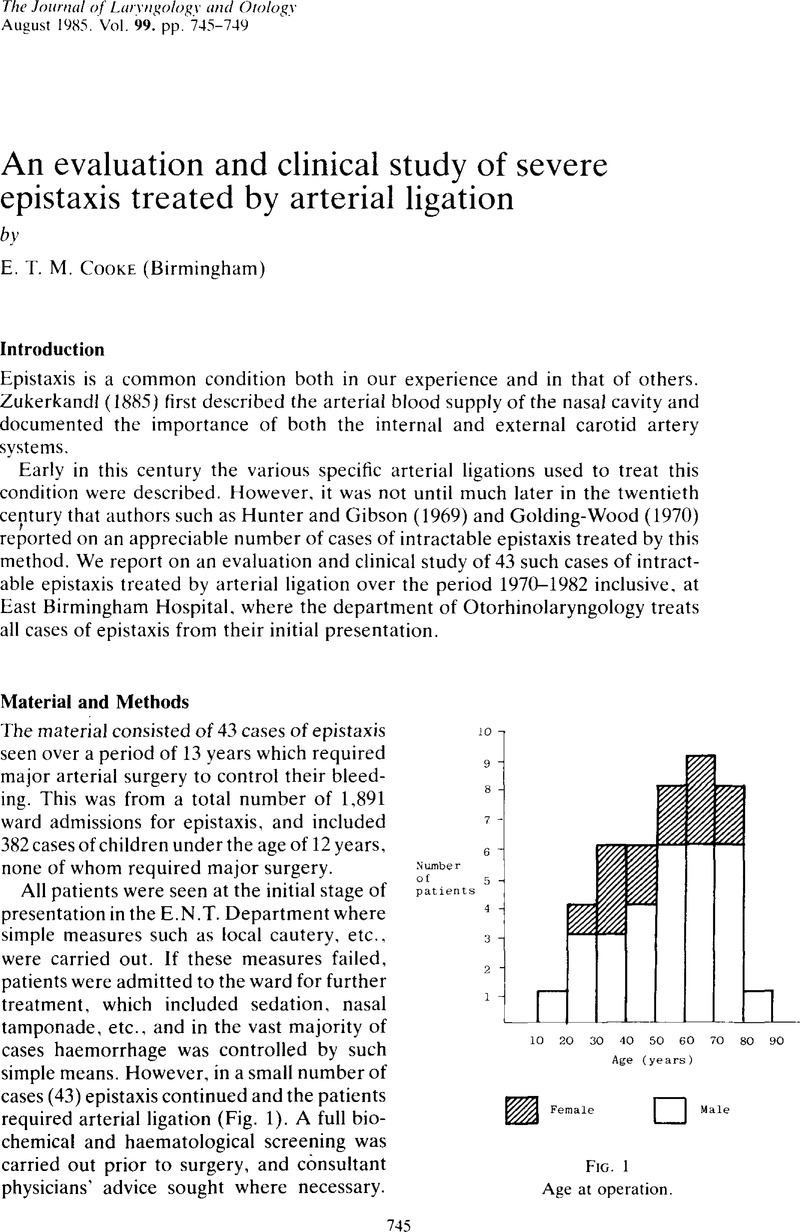Crossref Citations
This article has been cited by the following publications. This list is generated based on data provided by Crossref.
Solomons, Neil B.
and
Blumgart, Ray
1988.
Severe late-onset epistaxis following le Fort I osteotomy: angiographic localization and embolization.
The Journal of Laryngology & Otology,
Vol. 102,
Issue. 3,
p.
260.
Dixon, J. A.
1989.
Spontaneous external carotid artery occlusion.
The Journal of Laryngology & Otology,
Vol. 103,
Issue. 7,
p.
710.
Watson, M G
and
Shenoi, P M
1990.
Drug-Induced Epistaxis?.
Journal of the Royal Society of Medicine,
Vol. 83,
Issue. 3,
p.
162.
Singh, Bharath
and
Med, M.
1992.
Combined internal maxillary and anterior ethmoidal arterial occlusion: the treatment of choice in intractable epistaxis.
The Journal of Laryngology & Otology,
Vol. 106,
Issue. 6,
p.
507.
Ardekian, Leon
Samet, Naama
Shoshani, Yitzhak
and
Taicher, Shlomo
1993.
Life-threatening bleeding following maxillofacial trauma.
Journal of Cranio-Maxillofacial Surgery,
Vol. 21,
Issue. 8,
p.
336.
Caliot, Ph
Plessis, JL
Midy, D
Poirier, M
and
Ha, JC
1995.
The intraorbital arrangement of the anterior and posterior ethmoidal foramina.
Surgical and Radiologic Anatomy,
Vol. 17,
Issue. 1,
p.
29.
Komiyama, Masaki
Nishikawa, Misao
Kan, Masanori
Shigemoto, Tatsuhiro
and
Kaji, Arito
1998.
Endovascular Treatment of Intractable Oronasal Bleeding Associated with Severe Craniofacial Injury.
The Journal of Trauma: Injury, Infection, and Critical Care,
Vol. 44,
Issue. 2,
p.
330.
Motamed, M.
Farrell, R.
Philpott, J.
and
Rea, P.
1998.
Claudication on mastication following bilateral external carotid artery ligation for posterior epistaxis.
The Journal of Laryngology & Otology,
Vol. 112,
Issue. 1,
p.
73.
Ardekian, L.
Rosen, D.
Klein, Y.
Peled, M.
Michaelson, M.
and
Laufer, D.
1998.
Life-threatening complications and irreversible damage following maxillofacial trauma.
Injury,
Vol. 29,
Issue. 4,
p.
253.
Stamm, Aldo Cassol
Ferreira, Glaura Pimentel
Navarro, João A. Caldas
and
Freire, Luiz A. Silva
2000.
Micro-endoscopic Surgery of the Paranasal Sinuses and the Skull Base.
p.
393.
Isaacson, Glenn
and
Monge, Janet M.
2003.
Arterial Ligation for Pediatric Epistaxis: Developmental Anatomy.
American Journal of Rhinology,
Vol. 17,
Issue. 2,
p.
75.
Passey, J. C.
Srinath, V. S.
and
Meher, Ravi
2003.
Internal maxillary artery ligation for idiopathic intractable epistaxis.
Indian Journal of Otolaryngology and Head and Neck Surgery,
Vol. 55,
Issue. 1,
p.
51.
Razdan, Urvashi
Raizada, R. M.
and
Chaturvedi, V. N.
2004.
Efficacy of conservative treatment modalities used in epistaxis.
Indian Journal of Otolaryngology and Head and Neck Surgery,
Vol. 56,
Issue. 1,
p.
20.
Zaft, Scott V.
and
Greenough, William B.
2004.
Half A Purple Painful Tongue.
Journal of the American Geriatrics Society,
Vol. 52,
Issue. 6,
p.
1030.
Jeroukhimov, Igor
Cockburn, Mark
and
Cohn, Stephen
2004.
Facial Trauma.
p.
1.
Bouloux, Gary F.
and
Perciaccante, Vincent J.
2009.
Massive Hemorrhage During Oral and Maxillofacial Surgery: Ligation of the External Carotid Artery or Embolization?.
Journal of Oral and Maxillofacial Surgery,
Vol. 67,
Issue. 7,
p.
1547.
Dallan, Iacopo
Tschabitscher, Manfred
Castelnuovo, Paolo
Bignami, Maurizio
Muscatello, Luca
Lenzi, Riccardo
Battaglia, Paolo
and
Sellari-Franceschini, Stefano
2009.
Management of Severely Bleeding Ethmoidal Arteries.
Journal of Craniofacial Surgery,
Vol. 20,
Issue. 2,
p.
450.
Patel, Zara M.
and
Govindaraj, Satish
2010.
The Prevention and Management of Complications in Ethmoid Sinus Surgery.
Otolaryngologic Clinics of North America,
Vol. 43,
Issue. 4,
p.
855.
Westin, Gregory G.
and
Adelman, Mark A.
2016.
Management of the carotid arteries during carotid and vagal paraganglioma surgery.
Operative Techniques in Otolaryngology-Head and Neck Surgery,
Vol. 27,
Issue. 1,
p.
47.
Moon, Sungjun
2018.
Comprehensive understanding of vascular anatomy for endovascular treatment of intractable oronasal bleeding.
Yeungnam University Journal of Medicine,
Vol. 35,
Issue. 1,
p.
7.





